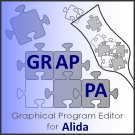Alida - Advanced Library for Integrated Development of Data Analysis Applications
...formerly known as Alida - Automatic Logging of Process Information in Data Analysis
What is Alida?
Alida defines a concept for designing libraries and toolkits in data analysis. It supports and simplifies integrated algorithm development by inherently joining algorithm implementation, automatic analysis process documentation and fully generic generation of user interfaces. In Alida each data analysis or manipulation action is realized in terms of an operator that acts on given data to produce desired output data. As all operators implement a common interface definition, their input and output parameters are accessible in a standardized manner, and they can also be invoked in a predefined way. Alida's concept is well-suited to ease algorithm development and their application to real-world problems by non-expert users. Due to the operator interface definition and the unified handling of operators it is for example possible to automatically generate user interfaces for operators, i.e. graphical frontends or commandline interfaces.
The Alida concept is independent of a specific programming language, however, relies on an object-oriented design. Moreover, in particular Java renders it quite easy to implement the conceptual features of Alida due to its reflection and annotation mechanisms. Consequently currently there is only active maintenance and support for the Java implementation of the concept. A prototypical C++ implementation is also available, however, still lacks a lot of features and is in general at a rather early stage.
The Java implementation of the Alida concept is in a quite mature state. It provides a framework for implementing and running operators. It also includes automatic process documentation and automatically generated command line and graphical user interfaces. Calls to operators not only produce data analysis results, but are at the same time registered within the framework together with all input and output objects as well as parameters settings of the various operators. These data acquired during an analysis process and the order of operator calls form a directed graph datastructure containing all relevant information for later reconstruction or verification of the analysis procedure.
The Java implementation of Alida allows to make the directed graph datastructure explicit in terms of XML representations which can be visually explored with appropriate graphical frontends like Chipory, or might be stored in data bases for archival purposes.
Grappa
- Grappa - the Graphical Programming Editor for Alida
Since release 2.0 Alida extends its operator concept towards combining operators into more complex workflows.
A workflow is defined as a combination of operators being excuted sequentially, in parallel or in a nested fashion.
The design of such workflows can best be done graphically, and Alida's core not only allows GUIs to be automatically generated,
but also
significantly simplifies graphical programming. In particular, now the Java implementation of Alida includes Grappa, a graphical programming editor for designing workflows.
Grappa provides users with an intuitive tool for developing sophisticated image analysis workflows.
All Alida operators are right away available as operator nodes in Grappa and form the building blocks for workflows.
|
|
How to get Alida?
- you can download Alida 2.6 here.
You can find the API documentation for this release here.
Furthermore Alida offers you a user and programmer guide
which you can download here.
Latest News
The news archive can be found here.
|
